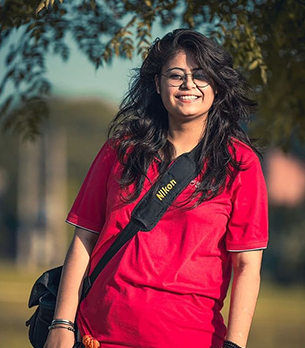The train was super crowded, I could see-smell-feel the sweat of the passengers around me.
The late afternoon heat of Bengal was beginning to make me dizzy and the crowd of
overpowering sensations was making me drift off to a distant land, without physically moving an
inch. In the midst of this travel between the land of sleep and wakefulness, I heard a sound so
deep and commanding that it pulled me from my semi conscious state of day-dreaming and
slammed me face to face with a man whose eyes seemed to see right through me. In saffron
clothes and with a strange one stringed instrument in hand, the man seemed to sing of the
unattainable love of the divine. It felt as if someone was both singing a lullaby and moaning a
great loss at the same time.
Baul is an ancient art form recognized by UNESCO as an important intangible heritage. It involves the performance of mystic poetry using song, dance and multiple instruments. With roots in Sufism, Buddhism and Hinduism, this syncretism has also challenged the status quo with humorous and radical questions about barriers in society such as caste, class and gender which take away from unconditional love. Youth participation is central to the work of upholding an ancient tradition and bringing a fresh breath to its practice. Especially the intersection of youth and feminism can bring Baul to vibrant new space of creativity and critical outlook that is so lacking in the South Asian Mainstream. Furthermore, in the context of Baul, because it is a lifelong practice in an immersive education system, the timeframe of learning the art-form is much longer than modern forms of education. In this context the average established Baul tends to be a senior citizen, and a young Baul may refer to anyone from a child to 40 year-old.
The Baul community is definitely an off shoot of the Bhakti movement but it is hard to tell exactly when and how this community developed. They are known for their unconventional behavior and for the freedom and spontaneity of their mystical verse. Their membership consists both of Hindus (primarily Vaishnavites) and Muslims (Sufis or fakirs). Their songs frequently deal with the love between the human personality (Atman) and a personal God (Brahman). The merger of the two is embodied in the concept of the ‘Moner manush’. Bauls constitute both a syncretic religious sect and a musical tradition. The origin of the word Baul is debated but the source lies in three possibilities, all of which are consistent with the modern sense of the word, which denotes the inspired people with an ecstatic eagerness for a spiritual life, where a person can realize his union with the eternal beloved – the Moner Manush (the person of the heart): – Ba’al, a branch of sufism literally meaning the intoxicated one. Votaries of this sect date back to 8 th -9 th century in Iran. They were fond of music and participated in secret devotional practices based on sexual free-mixing. They rejected family life and all ties and roamed the desert, singing and in search of their beloved.
- Vatula, meaning enlightened/ lashed by the wind to the point of losing
one’s sanity/ God’s madcap/ detached from the world/ seeker of truth - Vyakula, meaning restless/ agitated
The bauls practice secret devotional rites (Gupt Gyaan), centering on the belief that the human body is the seat of all truths. In this, there is a fusion of the Sahajiya and Sufi concepts of devotion. According to the Sahajiya philosophy, along with an external form, every object also has an internal form. This internal form is the eternal, otherwise known as sahaja. To feel the sahaja is to feel the internal eternity in one’s self. Bauls do not believe in organized religion and do not frequent mosques or temples. They follow the bhakti ideology of being iconoclasts and humanists who believe that all human beings are equal, irrespective of caste and creed. While there are some ascetic Bauls (Sanyasis) there are no restrictions on men and women living together (Grihasta). In fact, certain Baul rites are based on the combined devotional practices of a man and a woman (Jog sadhana). The ideas of companionship in Bauls is extremely progressive and sometimes misunderstood without proper context. Hence a lot of the rites are kept secret, so as to minimalise interference from those outside the community. Bauls call the beloved Sain (Lord), Murshid (guide) or guru (preceptor) and it is in his search that they go ‘mad’
Bauls have ghars (literally house or lineage) or guru traditions. These ghars are named after the principal baul guru: Lalon Shahi, Panju Shahi , Delbar Shahi and Panchu Shahi. A special section of the Bauls is known as Kartabhaja. They follow Vaishnava traditions and are known as ‘sati mayer ghor’. These ghars or gurudharas have some slight difference in devotional rites and music. Ascetic bauls renounce family life and society and survive on alms (madhukori). They have no fixed dwelling place but move from one Akhada (community house) to another. Akhadas are located at some distance from the rest of the village and may also develop around the graves of gurus. Bauls do not beget or rear children.
They are treated as ‘jyante mara’ or outcastes. Women, dedicated to the service of ascetics are known as Sevadasis. A male Baul can have one or more sevadasis who are associated with him in the act of devotion. A sevadasi may also leave one Baul and get associated with another. There is asimple ritual for that in the Joydeb Mela that is held once every year. An ascetic Baul alone can initiate a person into the community. The relation between the initiator and the initiate is similar to that between a pir and his murshid. Once initiated, even non-ascetic Bauls are forbidden to have children, though some may do so with their guru’s permission. Thus Baul is not a hereditary identity, it is one of choice and practice.
Baul songs are usually of two kinds – Dainya and Prabarta. These are also known as raga Dainya and Raga Prabarta but are not the Ragas of classical music but of bhajans (devotional songs). Songs are sung to the accompaniment of instruments such as the ektara, dugdugi, khamak, dholak, sarinda and dotara. The common tals are dadra, kaharba, jhumur, ektal or jhanptal. The singers dance and do the raqs as they sing. Sometimes the footwork may also denote a mandala or a specific geometric shape to amplify the energy of the song. The songs are elegiac in tone, reflecting the pain of deprivation or longing. They are inspired by the idea that the human body is the seat of all truths and by the search for a guru or maner manus. Every song may be interpreted in two ways: in terms of human love and in terms of divine love. Bauls refer to these two ways as lower stream and upper stream. Bauls concentrate much of their mystic energies on the four body fluids, on the nine-doors (openings of the body), on prakriti (nature) as primal motive force, and on breath.
15 th century Bhakti poet Pipa says,
Within the body is the God, Within the body the temple, Within the body all the Jangamas Within the body the incense, The lamps and the food offerings, Within the body the puja-leaves After searching so many lands, I found the nine treasures within my body, Now there will be no further going and coming I swear by the divine within me.
Within the form itself, one particular artist who has inspired me immensely is a tiny minstrel with locks that outgrow her own height – Mousumi Parial a.k.a Parvathy Baul. Her space in Shantiniketan – The Ekatara Kalari – is the physical manifestation of the principles of the Baul community. The work is essential, both as a need of the time and as a need for the community itself. This collection and dissemination of resources pertaining to Baul has never been done before with the sensitivity and depth that comes from an organisation both part of the Baul community and exposed to global feminism. Specifically the documentation of the role of women in Baul is a large gap in the research undertaken so far, and one that must be filled to understand this tradition in its entirety.





